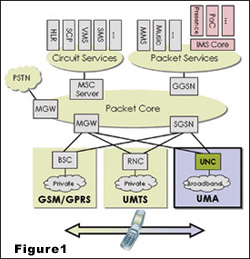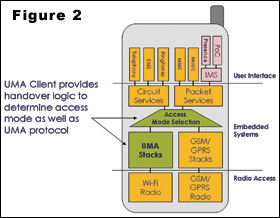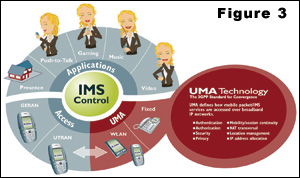|
Unlicensed Mobile Access (UMA) has become a hot topic for global operators and service providers looking to address the opportunity for Fixed/Mobile Convergence (FMC) and, more specifically, mobile/WiFi convergence (MWC). This relatively new technology has suddenly found itself compared with IMS, creating confusion in the marketplace where there is little understanding of how the technologies compete, co-exist, or potentially enhance each others role in the network. This article will clarify the different roles that UMA and IMS technologies play with respect to convergence for mobile operators, as well as for integrated operators that own both fixed and mobile access networks.
Today, mobile operators are looking to capitalize on the revenue potential of IMS-based data applications like streaming video, music downloads, interactive gaming, and videoconferencing. At the same time, they are challenged to optimize such next-generation applications in light of limited bandwidth, high latency, and the relatively high cost of cellular radio access networks (RANs). The economics are clear: the faster the network, the better the user experience and the better the user experience, the higher the adoption rate and average revenue per user (ARPU).
UMA is the 3rd-Generation Partnership Project (3GPP) standard for enabling subscriber access to mobile services including IMS applications over WiFi and broadband IP networks. UMA turns existing Wireless LANs (WLANs) into seamless extensions of mobile wireless networks, enabling subscribers to automatically roam between the cellular network and a home, office, or public WLAN, with full access to all applications from every location. With UMA, IMS-based applications are available to subscribers wherever they roam.
UMA Design Goals
UMA was designed to leverage existing, standard interfaces to ensure the technology would have minimal impact to operators core networks already in place. Furthermore, it was designed to provide access layer mobility to circuit services (CS) and packet services (PS) to make WiFi and IP a seamless extension of the operators network. The UMA network controller is integrated as an element of the operators existing radio access network (RAN), which provides several important benefits.
First, as an element of the RAN, the UMA system is linked at the physical layer with other RAN elements. Handing a voice or data session between disparate network elements is a difficult proposition; however, by integrating directly with the mobile access network, UMA is ideally situated to manage the millisecond timing to ensure seamless mobility. 
Second, integration into the RAN ensures that the switching layer of the mobile network is not impacted by the addition of UMA network elements. The operators existing MSC and GSN infrastructure can immediately take advantage of IP and WiFi with no modification or disruption, thus ensuring immediate support for all MSC/GSN layer services, such as lawful intercept, emergency services, directory assistance, billing, and customer care (Figure 1).
Finally, as an element of the access network, UMA ensures support for all value-added network-level services. To maintain a consistent experience, operators must provide support for all new and future value-added applications, like SMS, MMS, ring tones, PoC, and other advanced applications. As an access layer technology, UMA ensures that todays applications, as well as tomorrows SIP-based services, move seamlessly between networks.
Consistent Mobile Experience
From the beginning, the designers of the UMA specification set out to define a solution to break the cost and performance barriers that have to date limited fixed-to-mobile substitution in the home or office.
To increase mobile service usage indoors, UMA is designed to ensure users have a consistent mobile experience, that operators have minimal network disruption, and that the technology fits within an operators long range network plans. Subscribers expect mobile services to work the same in GSM as in WiFi or any other access technology. The user interface on the handset must be common and consistent (Figure 2). If history has taught one thing, its that the consumers in the mass market do not want to do anything special to receive a service.

To meet these goals, UMA is implemented as an embedded driver within the mobile platform. It is not a client application that is loaded onto the phone. Rather, as the subscriber moves from the GSM network to the UMA environment, the association and handover occurs in the background and the subscriber does not experience any difference in quality, capabilities, and most importantly, user interface.
IMS and UMA
IMS (define - news - alerts), originally conceived by mobile operators as a common application platform to speed time to market for new data applications, has suddenly become the unifying force in the telecom industry. As new approaches to mobile/WiFi convergence are developed, service providers need to evaluate technologies against user experience, ease of deployment, and the ability to align with future business and technology goals. The ability for UMA to provide seamless mobility for IMS applications ensures that the UMA and IMS technologies will be deployed side by side for years to come.
Fundamentally, UMA and IMS operate at different levels within the network (Figure 3). UMA is an access level technology, completely agnostic to the packet services or circuit services delivered over it. UMA provides for the convergence of mobile services over WiFi access networks. IMS, on the other hand, is access layer agnostic, meaning that with a secure and reliable IP connection, IMS applications can be delivered over GSM, UMTS, WiFi, UMA, or even DSL/cable.

UMA provides for circuit services (CS) and/or packet services (PS) to be seamlessly passed between the GSM and WiFi networks, which is accomplished through the use of a single UMA network controller. For many operators, the UMA approach to MWC meets the requirements for a dual-mode service.
What About SIP?
One of the most common comments about UMA is that it doesnt support SIP. SIP (define - news - alerts), of course, is the preferred protocol for initiating application and service sessions within the IMS domain. As mentioned, UMA is agnostic to the application/service layer. Conversely, applications and application protocols (like SIP) are essentially agnostic to the underlying access network.
As an access technology, UMA is more akin to the GSM or UMTS radio technologies than to SIP or H.323 signaling/application protocols. The industry understands that SIP runs on top of the UMTS network, yet SIP running over UMA can sometimes seem incomprehensible.
In fact, many operators today are deploying UMA-enabled devices with SIP applications. UMA provides the mobility for the SIP services between the WiFi and GSM networks, and SIP delivers new applications for the consumers.
UMA and VCC
While SIP does not specifically address mobility between radio networks, there is a work item started in the 3GPP to address how mobile/WiFi convergence may be addressed without UMA. The IMS approach to providing MWC is actually a new work item in the 3GPP known as Voice Call Continuity (VCC).
VCC is working to define how a SIP/VoIP packet service can be transitioned to the existing GSM circuit services network. Beyond the obvious technical hurdles of transitioning a call context from a packet network to a circuit network, VCC relies on the operator to invest in additional network elements to accomplish the vision.
The first investment is in the VCC network element itself. Touted by nearly every IMS vendor, VCC is a transitional gateway between the existing CS network and the PS VoIP core. Because it is still quite early in the definition phase, it is unclear if or how the VCC network element will support non-voice packet services that rely on session continuity will be supported.
Secondly, a new network access element is required to provide an access interface between the public internet and the operators IP core network. Based on the Inter-worked Wireless LAN (I-WLAN) specification, this network element was originally defined for laptops to gain access to mobile data services.
Lastly, VCC is reliant on the operator having invested in a new IMS voice switching infrastructure, which mobile operators today are not doing. Currently, the investment is in new Release 4 soft MSC switches from which the operators are looking to achieve significant operational savings from over the coming years.
Interestingly, the only operators investing in packet voice switching infrastructures today are the fixed line operators. Most fixed operators have parallel VoIP core investments underway to provide fixed line VoIP services in response to the competitive threat from Skype and others.
The Battle for the Building
Previous to fixed/mobile convergence, subscriber ownership was clear. Mobile minutes of use were billed to the mobile operator, regardless of the location of the call, and calls on the fixed network were billed to the fixed operator. Yet in a converged world, services and service providers are brought together. The fundamental question now is if a mobile phone is receiving service over the fixed line broadband network, which operator owns the subscriber and bills for the minutes the fixed operator or the mobile operator?
If the fixed line operator wishes to own the minutes of use when the subscriber is indoors, VCC is the technology approach of choice. VCC enables the fixed operator to leverage the VoIP switching infrastructure to deliver services when the subscriber is indoors and to transition the packet service to the GSM MSC when the subscriber moves outside range of the WiFi network. Conversely, UMA maintains subscriber ownership with the mobile operator when the mobile device is indoors.
As voice services and revenues continue their relentless migration to mobile devices, this becomes a question of investment in continuing to maintain voice services on the fixed network, or accelerating investment in the migration of voice services to the mobile network.
UMA for IMS Packet Voice Services
As mobile operators invest in IMS for the delivery of value-added packet services, UMA natively provides mobility for those services. Streaming audio, video conferencing, Push-ToTalk, and all other packet services are supported with seamless mobility today in UMA.
The next step comes when mobile operators begin the investment in IMS/SIP for packet voice services. The timing of this investment is predicated on the ability to provide a common user experience between networks. The consumer does not want to receive an enhanced SIP-based user interface when on the WiFi network and transition to the traditional circuit services interface when on GSM.
When the operator can provide a common user interface and experience, regardless of network, then investments will be made in new technologies. For the mobile operator, this means the ability to deliver a SIP-based enhanced user interface on the RAN, as well as on WiFi. As the operator invests in HSDPA/HSUPA and other evolutionary RAN technologies that enable the delivery of packet voice services, then a common user interface and user experience will be possible between the RAN and WiFi/IP networks.
Ultimately, it is UMA that will provide seamless mobility between the RAN and WiFi for these packet voice services. IT
Steve Shaw is director of marketing for Kineto Wireless. For more information, please visit the company online at www.kineto.com (news - alerts).
If you are interested in purchasing reprints of this article (in either print or PDF format), please visit Reprint Management Services online at www.reprintbuyer.com or contact a representative via e-mail at [email protected] or by phone at 800-290-5460.
|

